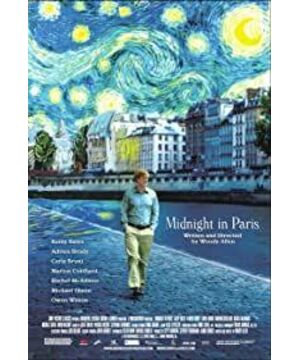Watching Woody Allen's movies often feel like I'm connoted. For example, many people have memories of the Belle Epoque! Just like every autumn, there will always be a few "pretending to be in Peking" with fallen leaves and gray tiles in the circle of friends.
Well, friends who think I have alluded to please don't rush to block the black! This is actually human nature. The imagination of another country in another era is largely due to our dissatisfaction with real life. Replenishing the brain can help physical and mental health, and there is nothing wrong with it.
The movie "Midnight Paris" probably tells such a story.
There is a man who is a little afraid of marriage, and his career has encountered a bottleneck. I just want to escape from real life, dreaming about living in Paris in the 1920s all the time, even on a rainy day.
What kind of era is that? It was about what Hemingway wrote in his last book "A Feast of Flowing", Paris between 1921 and 1926.
In fact, the movie "Midnight Paris" is very suitable to be watched in contrast to "The Flowing Feast", which has a lot of gossip. As vulgar as me, I can find a happy one!
How do you confirm that you are traveling?
One night, the hero Jill was a little drunk, and he was dragged into a classic car in a daze. Stumbled into a banquet, at the banquet, he met the Fitzgerald and his wife.
Francis Scott Key Fitzgerald is a representative of the "Jazz Age". He is also the author of the famous "The Great Gatsby".
Here, in order to make the journey more realistic, two celebrities from different fields of the same time are also interspersed. Musician Cole Porter and dancer Josephine Baker. Of course, their career has just started at this time. It was not until 1925 that Josephine Baker began to make a name call. Although Cole Porter's music runs through the film, his golden age is the 1930s.
PS: In fact, the movie style is very restorative, it can be seen that it is very careful. However, seeing Fitzgerald coming out, the person in our family still said "Isn't this Dou Sen?" (Watching the Marvel series of movies is easier to affect the pleasure of traveling!)
It is normal to meet the Fitzgerald and his wife at the banquet, because the couple often drank all night long. Hemingway had a deep relationship with Fitzgerald, and he spent three chapters in the book "A Feast of Flowing" depicting the various kinds of grudges. "Sanda is jealous of Scott's work." Always thinking of interfering with him. "As long as he writes well, Shanda will start complaining about how boring he is, and then drag him to the next party."
The sex life between them is not particularly good, Shanda will date other men. For example, the matador Juan Belmonte (Juan Belmonte) who appeared in the movie
She also seems to be not satisfied with the "size issue". In the chapter "A Problem of Size", Hemingway stated that he had accompanied Fitzgerald to the Louvre and observed the statue of JJ. He comforted Fitzgerald, "You have no problem, there is nothing wrong with it. Looking down for yourself, it may appear to be shortened." "The carving is quite good, and most people will be satisfied with it."
I was shocked that the sculptures in the Louvre can still be seen in this way? If I have the opportunity to go again, I can also try to appreciate it again from the perspective of a writer. It was after they thought that Shanda had a mental breakdown for the first time.
The Fitzgeralds moved to France in 1924 and published "The Great Gatsby" in 1925. By the time Hemingway left Paris in 1926, it was actually not a few years during this period, but it seemed that a lot of things had happened.
Hemingway described Fitzgerald in "A Feast of Flowing", saying, "His talent is as natural as the pattern made of powder on the wings of the white butterfly." However, he does not know more about it than the butterfly. Realize that the wings have been damaged, but it is irreparable. And what ruined his wings were endless banquets, alcohol, and his wife Zelda.
Stein and her living room!
Another important scene in the movie is the living room of the American writer Gertrude Stein. Picasso, Matisse, and Stein’s lover Alice appear in this scene.
Stein's home and Shakespeare's Bookstore were important footholds for American writers at the time in Paris. This group of people often gather in these two places.
About the friendship between Hemingway and Stein. The part of Hemingway's self-report in "The Flowing Feast" is different from the description of "Shakespeare's Bookstore" owner Silvia Beech in her memoirs. Hemingway said that he was a bit "kongtong", and he had overheard Stein's nauseous name "kitty cat". But according to Silvia's recollection, after Hemingway and Stein quarreled, he wanted to reconcile but couldn't put it down. It looked like a "kitten". (This mainly refers to shyness.)
People will beautify their words and deeds, and sometimes even do this unconsciously. This is understandable. But one thing is very unified. They used to have a good relationship, but they also often quarreled fiercely.
Stein's home often receives visits from painters, writers, their wives and lovers. It's just that the wives are usually separated by Alice Ribbon, because it is difficult for them to join the topic of "esoteric issues".
In the movie, Jill first met Picasso and Modinha’s lover Adriana in a corner of Stein’s house where he did not participate in the discussion, which was quite reasonable.
Modinari only appears in the dialogue, he died in 1920. Indeed, he had a close relationship with Picasso during his lifetime. And Hemingway settled in Paris for 21-26 years. Adriana told Jill that Modinari had passed away, but the timeline was actually right.
At this time, Picasso was still a Cubist painter, pursuing the power of crystal structure. Of course, he is also engaged in a joint exhibition with the Fauvist painter Matisse, doing new explorations. Soon he will meet Dalí and start a small group with their gang, called surrealism.
Surrealism!
Another small group. [Surrealism] Artist Dali, and his friends. [Surrealism] film director Luis Buñuel, [Surrealism] photographer Man Ray.
Yes, I repeated Surrealism three times . Because they do belong to this group. Holding group for warmth and bundling marketing, in fact, has existed since ancient times. Only according to the timeline, their group has not formally taken shape at this time.
These three people have cooperated very well with each other. For example, Man Ray published the photo collection "Dali's Beard", and Luis Bunuel and Dali collaborated on the film "An Andalu's Dog".
PS: It is rumored that "An Andalu's Dog" is Dali and Bunuel teaming up to satirize the Spanish poet Federico García Lorca. Because in the Spanish map artillery, people from Andalusia are called dogs. The reason why the two of them left Spain and appeared in Paris was because they broke up with Lorca.
Of course, if the story happened before 1926, then Dali has not yet met his fellow Picasso, and he has no reputation. Yis Bunuel hasn't even become an assistant director yet. The path to fame of this small group will not begin to take shape until 1926.
In the second half of the film, Jill met Luis Bunuel again. Made some suggestions for his movie. "A group of people attended the party, but they couldn't leave after the banquet." He should be referring to the 1972 " Prudent Charm of the Bourgeoisie ."
Yes, is Jill a screenwriter? He might have thought about the addiction of a guide master.
The second layer through!
Jill accompanied Adriana through her ideal Belle Era, the post-impressionist era. From the perspective of art history, this is indeed an amazing era. Because from this era, painting deviated from realism and began to pursue freehand brushwork.
They went to the Maxim restaurant and the Moulin Rouge.
At the Moulin Rouge, I met Henri de Toulouse-Lautrec, a painter who specializes in the creation of the Moulin Rouge.
You will see in the movie that he seems to be shorter than others when sitting. Yes, his family intermarried close relatives in order to maintain the pure aristocratic lineage, so he suffers from congenital disabilities.
Together with Toulouse, Degas, who painted with ballerinas as the subject, and Gauguin, the one mapped in "The Moon and Sixpence" appeared.
Gauguin left Paris in 1886. It is certain that the time they crossed through the second floor was before this.
A suspected Marx couple appeared in a corner of the ballroom. But it should be similar. According to the timeline, they should be taking refuge in London.
Flash by
Two other poets appeared in the movie, but they passed by in a flash.
Djuna Barnes (Djuna Barnes) lived in Paris throughout the 1920s. She was the one who danced with Jill at the party.
And T·S·Elliott. Forgive me, it's really just a "flash" and it's hard for me to get a clear picture.
A little ending
In the movie, people who live in that era are complaining about the mediocre era and lack of imagination.
Actually-they are all right. Any era is mediocre. Because no matter how great you are, life will continue. People who eat whole grains and have seven emotions and six desires will always give birth to more troubles, and no one can live 100% happily.
If there is really something wonderful, it can only exist in the good memories of the past. Hemingway wrote in "A Feast of Flowing" that "Paris is never over." He missed the poor and romantic time in Paris, even if it didn't feel good to go hungry. Then why not cherish it? Isn’t the former wife, the former family very beautiful? .............. Obviously, he himself regretted it.
Only the things that cannot be obtained and the ones that cannot be returned are always in commotion! And those around you will always be disgusted with mediocrity and lack imagination.
Watching Woody Allen's movies often feel like I'm connoted. At this time, I thought of the classic paradox in "Annie Hall" again.
There are two old women traveling to the Catskill Mountains. One of them said, "Hey, the food in this place is terrible!"
The other said, "Isn't it, the portion is too small."
You see, my view of life is basically the same, although it is full of loneliness, pain, misery and misfortune, but I feel that everything is passing too fast.
That's it!
View more about Midnight in Paris reviews











